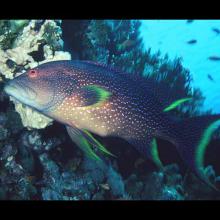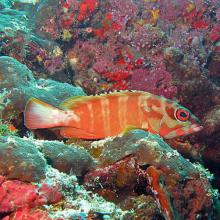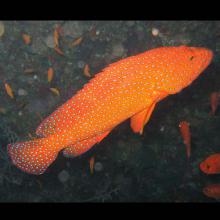Variola louti
Common name:
Yellow-edged lyretail
Genus:
Variola
Family:
Serranidae
Suborder:
Percoidei
Epinephelus fasciatus
Common name:
Black-tipped rock cod
Genus:
Epinephelus
Family:
Serranidae
Suborder:
Percoidei
Cephalopholis miniata
Common name:
Bluespot rockcod
Genus:
Cephalopholis
Family:
Serranidae
Suborder:
Percoidei
Variola louti
Common name:
Yellow-edged lyretail
Genus:
Variola
Family:
Serranidae
Suborder:
Percoidei
Epinephelus fasciatus
Common name:
Black-tipped rock cod
Genus:
Epinephelus
Family:
Serranidae
Suborder:
Percoidei
Cephalopholis miniata
Common name:
Bluespot rockcod
Genus:
Cephalopholis
Family:
Serranidae
Suborder:
Percoidei
Variola louti
Common name:
Yellow-edged lyretail
Genus:
Variola
Family:
Serranidae
Suborder:
Percoidei
Epinephelus fasciatus
Common name:
Black-tipped rock cod
Genus:
Epinephelus
Family:
Serranidae
Suborder:
Percoidei
Cephalopholis miniata
Common name:
Bluespot rockcod
Genus:
Cephalopholis
Family:
Serranidae
Suborder:
Percoidei
Family-Animalia: Serranidae
The Serranidae are a large family of fishes belonging to the order Perciformes. The family contains about 450 species in 65 genera, including the sea basses and the groupers (subfamily Epinephelinae). Although many species are small, in some cases less than 10 cm (3.9 in), the giant grouper (Epinephelus lanceolatus) is one of the largest bony fishes in the world, growing to 2.7 m (8 ft 10 in) in length and 400 kg (880 lb) in weight. Representatives of this group live in tropical and subtropical seas worldwide.
Characteristics
Many serranid species are brightly colored, and many of the larger species are caught commercially for food. They are usually found over reefs, in tropical to subtropical waters along the coasts. Serranids are generally robust in form, with large mouths and small spines on the gill coverings. They typically have several rows of sharp teeth, usually with a pair of particularly large, canine-like teeth projecting from the lower jaw.
All serranids are carnivorous. Although some species, especially in the Anthiadinae subfamily, only feed on zooplankton, the majority feed on fish and crustaceans. They are typically ambush predators, hiding in cover on the reef and darting out to grab passing prey. Their bright colors are most likely a form of disruptive camouflage, similar to the stripes of a tiger.
Reference: Wikipedia



